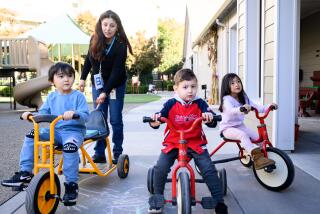Research Examines Why Some Kids Are Shunned by Peers
- Share via
NEW YORK — Shunned in the classroom and the playground, they are the kids who are disliked by just about everybody.
Some fly off the handle for no apparent reason. Some just don’t seem to know how to act with their peers.
“Socially rejected” children comprise maybe one-tenth of the nation’s grade-school classes. They run a risk of truancy, repeating grades, becoming depressed and anxious, and dropping out. In later life, they show heightened rates of juvenile delinquency and mental health problems.
Recent research into why some children are rejected shows that they are a mixed group. Many children apparently haven’t learned normal social skills. Others have learned the wrong lessons too well.
Researchers are far from solving the problem, but they say they have found ways to help some children, at least temporarily.
“We’re not turning rejected kids into well-liked, well-adjusted kids yet, (but) we’re moving in the right direction,” said psychologist Karen Bierman of Pennsylvania State University.
Rejected children aren’t those who simply don’t attract much attention from classmates, or who lose battles for status among their peers. They’re “those kids who are at the real bottom,” said Ken Dodge, psychology professor at Vanderbilt University in Nashville, Tenn.
A key mystery is whether the other troubles are caused by the experience of being rejected or stem from other factors, and the rejection merely indicates a child’s peers can identify those factors early, said psychologist Martha Putallaz of Duke University. Bierman suspects that both play a role.
In any case, researchers have proposed three major explanations for rejection: lack of certain social skills, aggressiveness and the way children of an “in group” treat non-members. A given rejected child may be affected by more than one of these problems, Bierman said.
Much research focuses on the idea that children are rejected because they lack certain social skills. They consistently misinterpret people’s intentions, for example, and don’t know how to enter groups of children at play or to solve common social dilemmas properly.
Dodge’s research has shown that rejected children are less accurate than others in reading the intentions of people in videotaped vignettes. They tend to assume hostility where none exists--which is important because his work has also shown that much peer conflict arises through misinterpreted motives.
If a child bumps another and takes his place in line, most children at the scene may realize it was an accident. But the bumped child may misperceive the episode as an aggressive act and retaliate aggressively, Dodge said.
Putallaz, focusing on another skill, found that unpopular grade-school children behaved differently from popular kids when they tried to join other children in play. Unpopular children were more likely to be disagreeable, as in disapproving of another’s behavior or possessions, and were also more likely to state their feelings, talk about themselves, ask questions and abruptly change the subject of conversation.
In short, they seemed to be trying to call attention to themselves rather than blending into the activities of the group, Putallaz said. The strategy did not go over well; unpopular children needed more time and more attempts to enter a group than popular children did.
Dodge said he believes the work applies to rejected children too.
Programs that include teaching and practicing social skills can help improve some rejected children’s behavior for at least several months, leading in some cases to improved social standing, he said. But children have not been followed long enough to show whether such programs can reduce the risk of later behavioral and psychological problems.
A second explanation for rejection is gaining acceptance as researchers focus on aggressive behavior of rejected children, Bierman said. Perhaps a third to a half of rejected children are unusually aggressive, she said.
These children may have learned at home that tantrums and other obnoxious behavior can get them what they want. Then they carried that lesson to school.
In this hypothesis, the problem is parents who give a lot of commands but fail to back them up. Instead, they occasionally give up in the face of yelling or tantrums. The process escalates as parents become angry and essentially compete with their screaming children to see who can be more obnoxious.
In the end, children learn from the process that anger is the way to solve a problem, Bierman said.
Some researchers suspect that such children find that if they get angry and scream in school situations, such as losing an argument, their peers and even teachers will let them have their way--reinforcing the idea that aggression is the way to face a problem, she said.
Intervening with this kind of child involves working with parents, teachers and peers so they no longer reward aggressive behavior. Research suggests that such programs can help reduce aggression but are difficult to do in school because the children are so obnoxious that others often hesitate to help, Bierman said.
The behavioral change often does not lead to better social status, she said. But her research suggests that peers may be more likely to change attitudes if they are involved in the treatment. They have a stake in the outcome, and they get a chance to find a more likeable child beneath the veneer of aggression.
The third overall explanation for rejection deals with how rejected kids stay that way. Essentially, it says that allegiances form between subgroups of peers, and part of such “in groups” is to identify and criticize non-members, effectively keeping them out of the group.
Children in this situation are helped by programs that combine them with in-group members to work for a common goal, so that in-group children and the rejected child get a chance to view each other in a new light.
This strategy has shown some short-term success in changing behavior, but its long-range impact is not known, Dodge said.
Regardless of the theory behind intervention programs for rejected children, Bierman said, the programs appear to do the least good for the most severely rejected children.
And other key questions remain unresolved:
Why do some children lack social skills most kids learn? Do children rejected in school tend to have the same problem in their neighborhoods or athletic teams? Could any support they find outside school be used to reduce their risk of the long-term problems associated with rejection?
Despite the uncertainties and lack of effective treatment in some cases, Bierman said, research does offer hope to some rejected children.
“We know enough to start working with a child and family,” she said. “We know things to try, and for some kids we will have very good success.”






